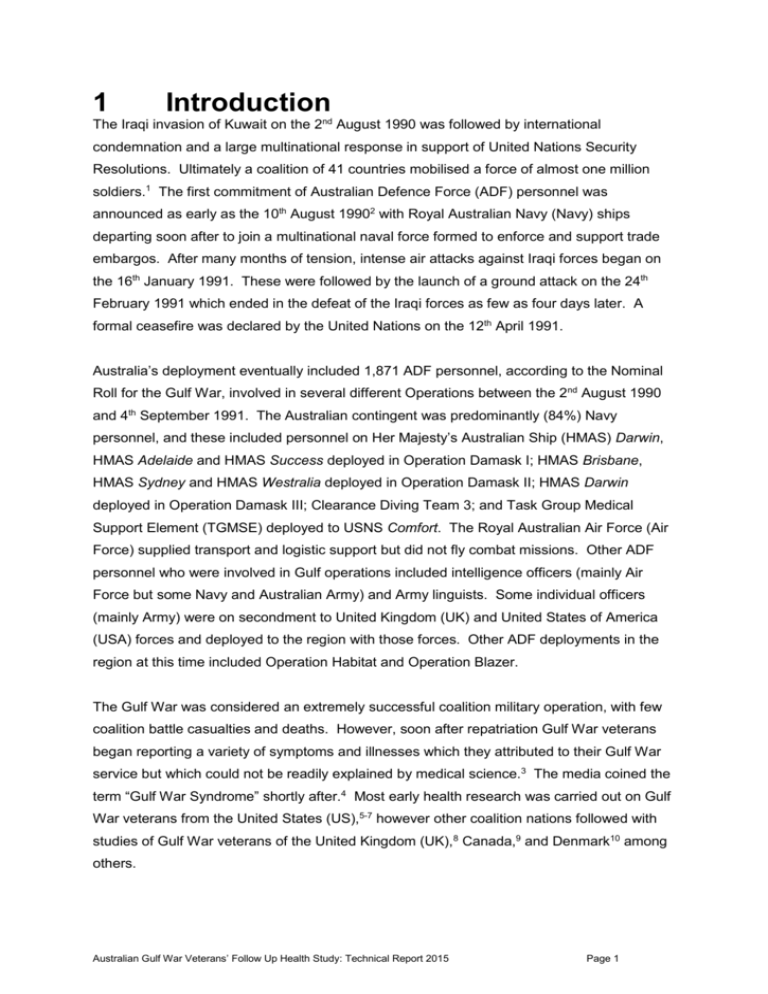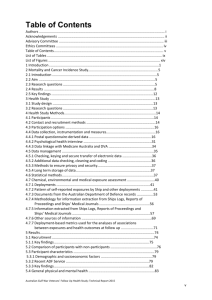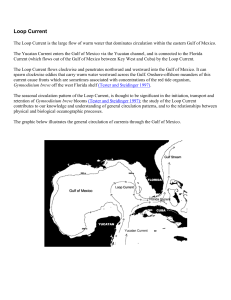Introduction - Department of Veterans` Affairs
advertisement

1 Introduction The Iraqi invasion of Kuwait on the 2nd August 1990 was followed by international condemnation and a large multinational response in support of United Nations Security Resolutions. Ultimately a coalition of 41 countries mobilised a force of almost one million soldiers.1 The first commitment of Australian Defence Force (ADF) personnel was announced as early as the 10th August 19902 with Royal Australian Navy (Navy) ships departing soon after to join a multinational naval force formed to enforce and support trade embargos. After many months of tension, intense air attacks against Iraqi forces began on the 16th January 1991. These were followed by the launch of a ground attack on the 24th February 1991 which ended in the defeat of the Iraqi forces as few as four days later. A formal ceasefire was declared by the United Nations on the 12th April 1991. Australia’s deployment eventually included 1,871 ADF personnel, according to the Nominal Roll for the Gulf War, involved in several different Operations between the 2nd August 1990 and 4th September 1991. The Australian contingent was predominantly (84%) Navy personnel, and these included personnel on Her Majesty’s Australian Ship (HMAS) Darwin, HMAS Adelaide and HMAS Success deployed in Operation Damask I; HMAS Brisbane, HMAS Sydney and HMAS Westralia deployed in Operation Damask II; HMAS Darwin deployed in Operation Damask III; Clearance Diving Team 3; and Task Group Medical Support Element (TGMSE) deployed to USNS Comfort. The Royal Australian Air Force (Air Force) supplied transport and logistic support but did not fly combat missions. Other ADF personnel who were involved in Gulf operations included intelligence officers (mainly Air Force but some Navy and Australian Army) and Army linguists. Some individual officers (mainly Army) were on secondment to United Kingdom (UK) and United States of America (USA) forces and deployed to the region with those forces. Other ADF deployments in the region at this time included Operation Habitat and Operation Blazer. The Gulf War was considered an extremely successful coalition military operation, with few coalition battle casualties and deaths. However, soon after repatriation Gulf War veterans began reporting a variety of symptoms and illnesses which they attributed to their Gulf War service but which could not be readily explained by medical science.3 The media coined the term “Gulf War Syndrome” shortly after.4 Most early health research was carried out on Gulf War veterans from the United States (US),5-7 however other coalition nations followed with studies of Gulf War veterans of the United Kingdom (UK),8 Canada,9 and Denmark10 among others. Australian Gulf War Veterans’ Follow Up Health Study: Technical Report 2015 Page 1 During the decade following the Gulf War, Australian veterans became increasingly concerned about the effects of that war upon their own health. Based on submissions from its members, the Australian Gulf War Veterans’ Association compiled a report outlining their health concerns, likely exposures and the supporting evidence linking veterans' chronic ill health with service in the Gulf.11 Included amongst the Australian Gulf War veterans’ numerous health concerns were reports of joint pain, headaches, stomach cramps, shortness of breath, skin problems, nightmares, fatigue, short term memory problems, irritability, mood swings, depression, suicidal thoughts, loss of sexual libido, increased startle response and clumsiness.11 In 2000, the Australian Government Department of Veterans Affairs (DVA) commissioned, through competitive tender, a cohort study of the health of ADF personnel who were deployed to the Gulf region during that conflict (the Australian Gulf War veterans) and a comparison group of ADF personnel who had not deployed to that conflict. The resulting Australian Gulf War Veterans’ Health Study was undertaken by a research team based primarily at the Monash University Centre for Occupational and Environmental Health (MonCOEH). Data collection for, what is now termed, the baseline Australian Gulf War Veterans’ Health Study commenced in mid-2000 and concluded in late 2002. The baseline health study included the entire cohort of ADF personnel included on the Nominal Roll for the Gulf War and a frequency matched comparison group of 2,796 ADF, or formerly ADF, personnel who had been in operational units at the time of the Gulf War but who had not deployed to that conflict. The baseline study included extensive self-reported health and exposure data, also health data collected via face to face medical and psychological examinations, all-cause mortality and cancer incidence data sourced from Australian national registries, and some ADF service-related data collated from records maintained by the DVA. The results of the baseline study have been extensively reported in peer-reviewed scientific journals (e.g.12-20) and cited in published reviews of the international Gulf War veteran health literature (e.g.21). To summarise some of the key findings, the baseline health study found that, 10 years after the Gulf War, veterans were at significantly greater risk of a number of adverse health outcomes relative to the comparison group. These included a doubling of the risk of several fatigue and chronic fatigue-related outcomes, a four-fold increase in 12 month PTSD, an 80% increase in multisymptom illness, a 70% increase in 12 month major depression and a 60% increase in 12 month alcohol disorder, increased rates of general health-symptom and neuropathic-symptom reporting, increased rates of reporting for numerous doctor-diagnosed medical conditions; particularly gastrointestinal disorders, skin Australian Gulf War Veterans’ Follow Up Health Study: Technical Report 2015 Page 2 conditions and PTSD; and greater functional impairment in the previous two weeks and poorer self-perceived physical health status and mental health status. Objective measures of health, including blood pressure, physical fitness, body mass index, lung function, and the pattern of blood test abnormalities did not differ between the two study groups. Ten years after deployment, a number of Gulf War deployment-related characteristics and exposures were found to be associated with health outcomes in Gulf War veterans. Number of vaccinations, especially where ten or more were reported, number of pyridostigmine bromide tablets reportedly taken, being in a chemical weapons area and reported number of deployment-related stressors were all associated with higher symptom reporting, lower perceived physical health status and greater functional impairment in Gulf War veterans at baseline. Number of vaccinations reported was also associated with PTSD and psychological distress at baseline. Number of deployment-related stressors was also associated with affective, anxiety and substance use disorders, ten years after deployment. The baseline Australian Gulf War Veterans’ Health Study included an assessment of the mortality and cancer incidence experience of the cohort through linkage to the national death and cancer registries in 2002. At that time the numbers of deaths and cancers in the cohort were small and both were lower than those expected in the general Australian population. When Gulf War veterans and the comparison group were compared, there was a small excess of disease-related deaths in the veteran group, however the numbers were too small at that time to draw any meaningful conclusions from this. Included among the recommendations arising from the results of the baseline Australian Gulf War Veterans’ Health Study, was the recommendation that consideration be given to undertaking follow up studies, especially in relation to the cohort mortality and cancer incidence study, but also in relation to some of the health outcomes found in excess in Gulf War veterans, such that the longer term health sequelae of the Gulf War deployment could be monitored. In its most recent review of the vast health literature on Gulf War veterans internationally, the US Institute of Medicine (IOM) has recommended longitudinal monitoring of robust cohorts to carefully track the development of neurological and psychiatric conditions, also brain cancer and other long latency cancers, and additional health issues that occur at later age such as cardiovascular disease.21 The IOM specifically mentioned the usefulness of the Australian cohort for tracking frequently seen health outcomes such as ‘Gulf War illness’ (also termed Gulf War Syndrome or multisymptom illness), cardiovascular and respiratory diseases, other cancer types, and some psychiatric disorders.21 This report describes the first follow up of the health of the members of the Australian Gulf War Veterans’ Health Study cohort. This follow up study comprises two primary components; Australian Gulf War Veterans’ Follow Up Health Study: Technical Report 2015 Page 3 a study of all-cause mortality and cancer-incidence in the entire cohort using up-to-date data sourced from Australian national mortality and cancer registries, and a study of the health of those members of the cohort who participated in the baseline health study, using data collected from a self-report postal questionnaire, an over-the-phone psychological health interview and linkage with Medicare Australia- and DVA-held health data. This follow up health study has been funded under a services agreement through the DVA competitive Applied Research Program. The research has been conducted by MonCOEH researchers and collaborators. Data collection for the follow up study has been undertaken in the period 2011-2013, approximately ten years after the baseline study. Australian Gulf War Veterans’ Follow Up Health Study: Technical Report 2015 Page 4







